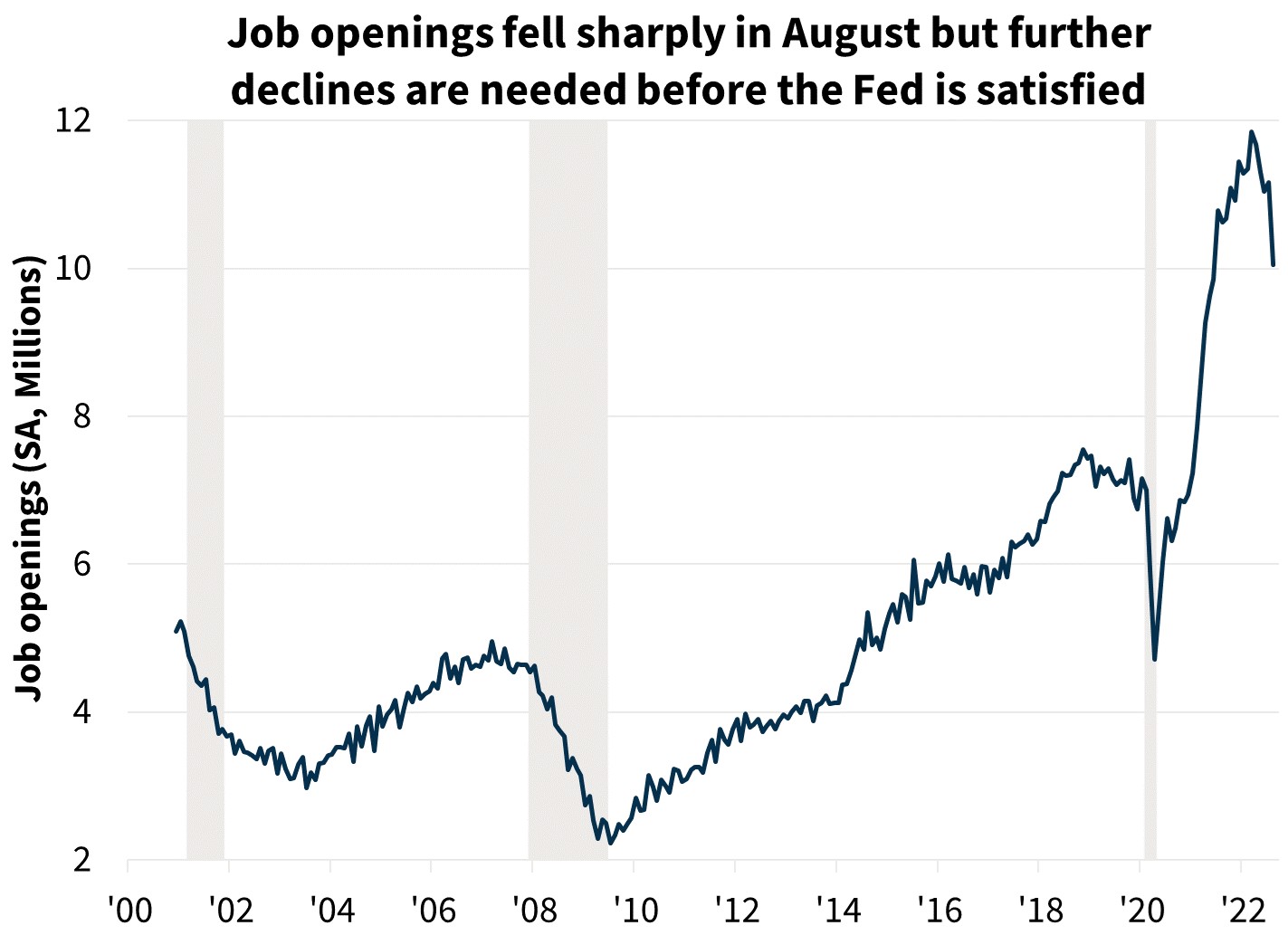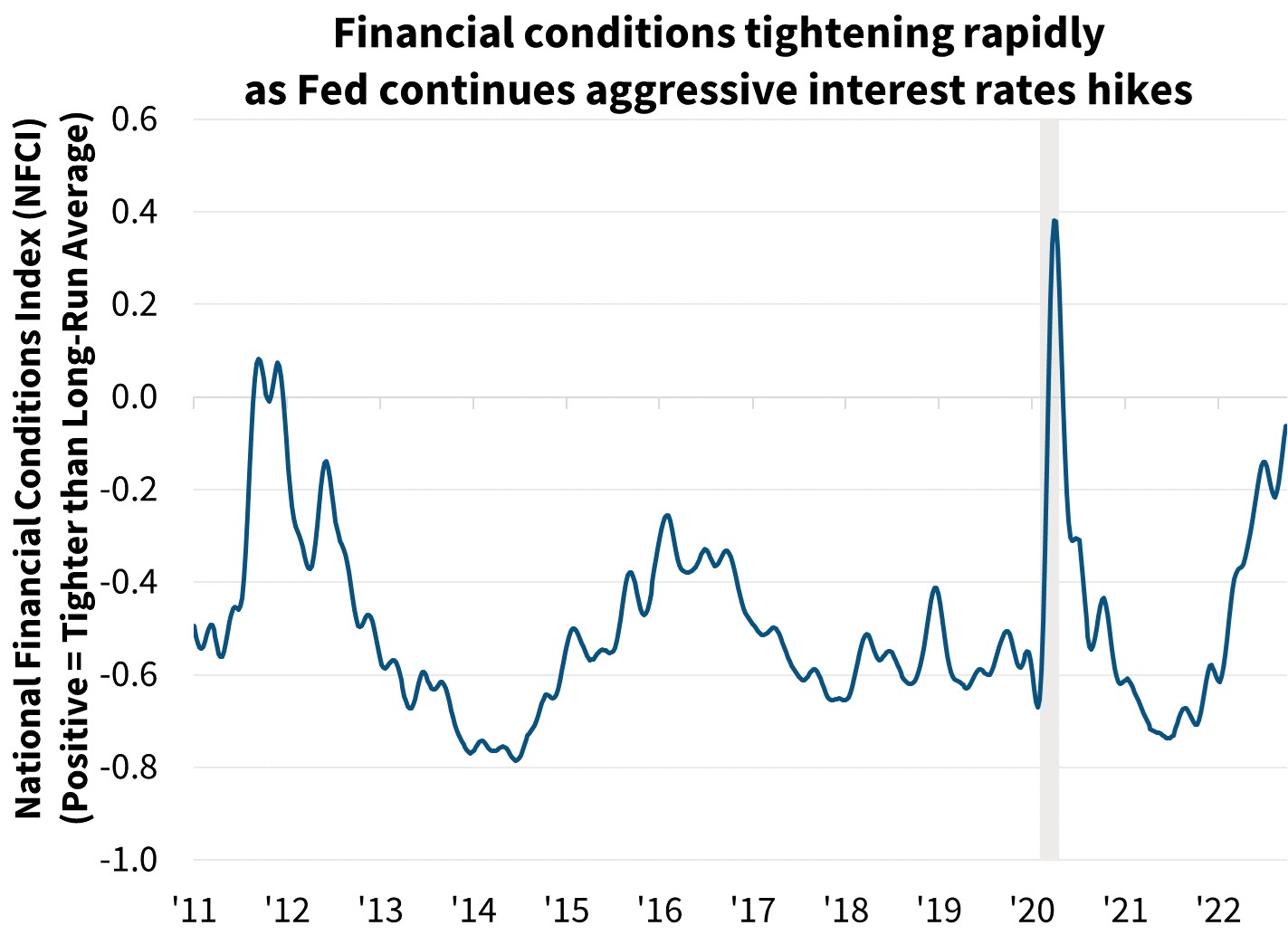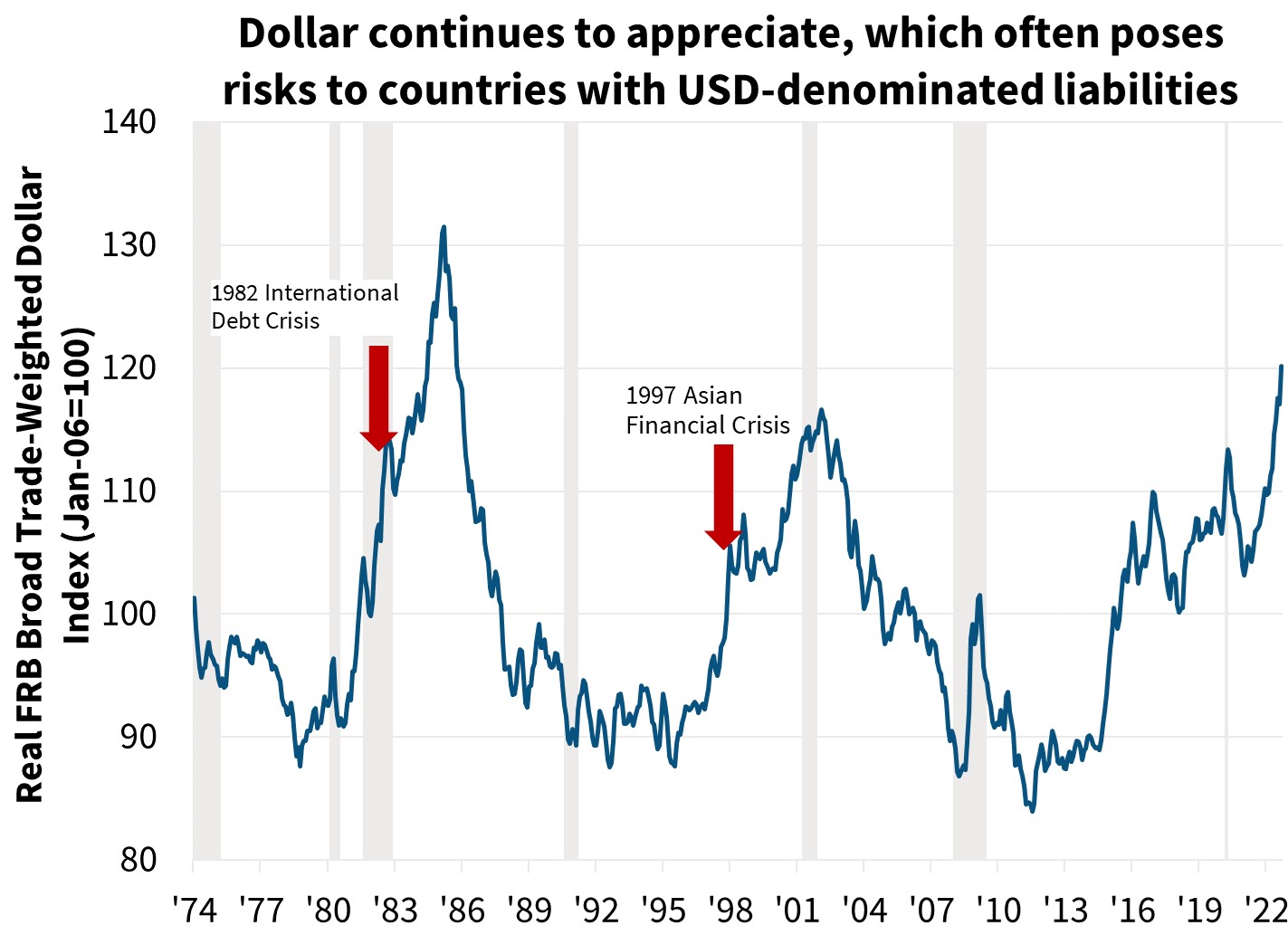The Fed Maintains Its Resolve as Markets Build in Risk
We have upgraded our Q3 gross domestic product (GDP) forecast to 2.3 percent annualized from 1.3 percent due primarily to incoming data showing a rebound in near-term net exports and business inventory investment. However, we believe this boost is likely to prove temporary, as it reflects a partial normalization in global trade following a historically large trade deficit in the first half of 2022. We forecast Q4 2022 GDP growth to be negative 0.7 percent annualized. Given sluggish consumer spending, the ongoing tightening of monetary policy, and additional signs of weakness in global economic and financial conditions, we continue to expect a moderate contraction will occur in 2023, with the unemployment rate ending 2023 over 5 percent. We project 2022 real GDP growth will be negative 0.1 percent on a Q4/Q4 basis, down one-tenth from our previous forecast. Our forecast for 2023 GDP growth on a Q4/Q4 basis is negative 0.5 percent, unchanged from the prior forecast.
We continue to expect the forecasted recession to be modest based in part on the relatively limited degree of labor market slack that we believe is necessary to alleviate above-target inflationary pressure; once achieved, we expect monetary policy will likely ease and the economy will return to growth. It should be noted, however, that historically in periods of rising interest rates and dollar exchange rate appreciation, there has been a tendency for financial crises to occur within the global economy. Given the speed at which interest rates have risen, we believe there is growing risk of such an event occurring over the coming quarters, which could lead to a deeper or more prolonged contraction than our base forecast expects.
We lowered our 2022 forecast for total home sales slightly to 5.64 million units, an 18.1 percent decline from 2021, down from our previous forecast of a 17.2 percent drop. The change was disproportionately due to a lower expectation for existing home sales given incoming data and higher mortgage rates (exceeding 6.6 percent according to the most recent Freddie Mac survey). Our total home sales outlook for 2023 was revised downward from 4.98 million to 4.47 million units.
Additionally, we have revised downward our forecast for home prices as measured by the Fannie Mae Home Price Index. We now anticipate 2022-year end home prices to rise 9.0 percent, down from a previous forecast of 16.0 percent. For 2023, we project home price declines of 1.5 percent, down from our prior forecast of home price growth of 4.4 percent. Given changes to our outlook for both home sales and mortgage rates, we have lowered our forecast for 2022 single-family mortgage originations to $2.33 trillion (previously $2.44 trillion), and our 2023 single-family mortgage originations forecast to $1.74 trillion (previously $2.17 trillion).
Early Signs of Labor Market Pressures Easing, But Additional Interest Rate Hikes Still Expected
While measures of economic growth have stagnated for much of this past year, labor market strength has stood out as an anomaly. Labor market tightness has contributed to heightened inflationary pressures, enough such that the current stated goal of Federal Reserve policy is to loosen the labor market. While payroll employment slowed only modestly in September, the August Job Openings and Labor Turnover Survey (JOLTS) showed job openings declining by 1.1 million. This is perhaps the first meaningful signal that the labor market may be loosening, and this metric is specifically one that the Fed is watching based on comments from Chairman Powell. We expect this measure to continue to decline, along with slowing payroll growth, over the remainder of the year, which is consistent with a likely economic contraction occurring in early 2023.
Based on recent comments from Fed officials, we do not expect the Fed to slow its pace of policy tightening until there is clear evidence of both a loosening labor market as well as decelerating core inflation measures. The Fed’s September Summary of Economic Projections (SEP) showed the median projection of the unemployment rate rising from 3.8 percent at the end of 2022 (it’s 3.5 percent currently) to 4.4 percent by the end of 2023. If the historical relationship between a such a rise in the unemployment rate and a recession holds true, this would signal the start of a recession in 2023. Still, the SEP shows the median expected Fed Funds rate is higher in 2023 (peaking at 4.4 percent) than at the end of 2022. Combined with comments suggesting the same, we expect the Fed is willing to tolerate a modest recession in 2023 to ensure inflation trends have reversed before ending its tightening course. Following the completion of our interest rate forecast, market expectations for the terminal fed funds rate have risen and we believe there is upside risk to our forecast of short-term rates peaking at 4.25 to 4.50 percent in Q1 2023, perhaps approaching 5 percent.
Surging Interest Rates and Dollar Strength Pose Risks to Financial Stability
Current financial conditions in the U.S., as measured by the Chicago Fed’s National Financial Conditions Index (NFCI), are still considered somewhat looser than average. However, the trend is clearly toward tighter conditions and are more restrictive than before the pandemic.
As global monetary policy continues to tighten, there is a growing risk that a weak point in the global financial system could buckle under the pressure of a higher rate environment. The related strengthening in the dollar exchange rate may also create pressure on foreign entities owing dollar-denominated liabilities. Historically, periods of rapid dollar appreciation have coincided with developing market financial crises, such as the Mexican Peso Crisis and the Asian Financial Crisis. We cannot predict if such events may occur, let alone when. The turmoil in the UK bond market in recent weeks is a reminder that market liquidity cannot be taken for granted, especially when central banks are tightening.
While it is not our base case forecast, we believe financial instability could lead to an earlier end to Fed policy tightening, in which case the central bank would pivot to provide greater liquidly to curtail any financial contagion. Volatility in interest rates over this past month has been driven in part by market speculation over when and if global monetary authorities were going to pivot. However, recent commentary from several FOMC members have stated a position of determination to keep raising rates to curtail inflation. As of this writing, futures markets anticipate an additional 75 basis point hike at the Fed’s next meeting.
Home Sales Slowing Further While Prices Begin to Decline
Home prices are now on the decline with both the FHFA Purchase-Only Index and the Case-Shiller Index falling over the month of July on a seasonally adjusted basis. On an annual basis, home price growth, as measured by the two indices, decelerated to 13.9 percent and 15.8 percent in July 2022, respectively, down from 16.3 percent and 18.1 percent in June 2022. With mortgage rates resuming their rise following a mid-summer pull back (at 6.66 percent as of this writing according to the most recent Freddie Mac survey), resulting in rapidly diminishing home purchase demand, we expect home prices to continue to decline in the near term. As measured by the Fannie Mae Home Price Index (FNM-HPI), we have revised downward our home price growth forecast for 2022 and 2023 from 16.0 percent and 4.4 percent, respectively, to 9.0 percent and negative 1.5 percent. On an annual basis, we forecast house price growth to turn negative beginning in Q2 2023.
While affordability measures are very stretched and median home prices are well-deviated from their historical relationship to typical household incomes, we do not anticipate that home price declines will result in a repeat of the Great Financial Crisis. Due to the minimal use of adjustable-rate mortgages (ARMs), teaser rates and exotic mortgage products, relatively few current single-family borrowers are subject to payment shocks from rising interest rates in the way many borrowers were in 2006-2008. We believe this factor, combined with more robust underwriting standards, as well as a stronger set of tools available for loan workouts and modifications compared to the housing crisis of 2008, will mitigate the impact of home price declines on mortgage delinquencies and foreclosures. Additionally, both residential real estate in aggregate and the overall financial system are less leveraged than they were prior to the past crisis, allowing more room to absorb credit losses that may occur from declining home prices.
According to the National Association of REALTORS®, existing home sales came in slightly stronger than expected in August at an annualized pace of 4.80 million. Still, this was a further decline from the month prior, and sales were down 19.9 percent from a year ago. Pending sales, which lead closings on average by 30-45 days, fell 2.0 percent in August, pointing to a further decline in existing home sales in September. Based on the Mortgage Banker Association’s weekly mortgage application survey, purchase mortgage application activity has also weakened in recent weeks. Combined with our upwardly revised interest rate expectation and our downgrade to projected home price growth, we have also lowered our outlook for existing home sales. We forecast total existing home sales will be 5.02 million in 2022 and 3.93 million in 2023. The latter would be the lowest annual pace since mid-2012.
Beyond diminished affordability, as mortgage rates continue to rise, we suspect the “lock in” effect, in which existing mortgage borrowers have rates well below current market rates, is limiting the number of move-up buyers. While total inventories of homes for sale are continuing to drift upward, this is largely due to a slowing pace of sales. According to Realtor.com, September new listings were down 9.8 percent from a year earlier. The combination of diminished affordability and the large financial disincentive for existing homeowners to take out a new mortgage at current market rates will likely continue to weigh on the pace of sales.
New home sales, in contrast, jumped by 28.8 percent in August to an annualized pace of 685,000, according to the Census Bureau, the highest since March. The surge coincided with the summer pullback in mortgage rates that has now passed. Therefore, we expect that the jump in sales will prove to be a temporary deviation from an otherwise downward sales trend. Still, the size of the gain led to a near-term upgrade to our new home sales and construction forecasts. While we expect sales declines to continue, there are growing numbers of statements from homebuilders pointing to an increased willingness to more heavily discount homes to drive sales volumes. This is consistent with the growing inventory of completed homes for sale, which increased 11.4 percent in August to the highest level in two years. Given much higher comparative inventory of new homes under construction, as well as easing cost pressures in building materials and an expected easing in labor market tightness, we expect new home sales to hold up better in the near term via more aggressive discounting relative to existing home sales.
While multifamily housing construction continues to move at a strong pace, signs of slowing rents and growing vacancy rates are beginning to develop. We forecast multifamily starts to slow meaningfully in 2023 following their torrid pace this year.
Mortgage Originations Revised Downward on Lower Home Sales and Price Outlook
We have downgraded our forecast for 2022 purchase mortgage origination volumes by $78 billion from last month’s forecast to $1.6 trillion, driven by recent incoming mortgage applications data as well as our downwardly revised outlooks for home sales and home price growth. In 2023, we expect purchase volumes to shrink by 18 percent year over year to $1.3 trillion, a downgrade of $338 billion from last month’s forecast, again driven by weaker home price expectations as well as significant downgrades to our forecast for home sales.
In the refinance market, we now expect 2022 volumes to total $701 billion, $30 billion lower than last month’s forecast, driven by declining refinance applications given the higher interest rate environment. We expect 2023 refinance volumes will be $392 billion, a downgrade of $98 billion from last month’s forecast, again reflecting our expectation for continued higher rates.
Economic & Strategic Research (ESR) Group
October 12, 2022
For a snapshot of macroeconomic and housing data between the monthly forecasts, please read ESR’s Economic and Housing Weekly Notes.
Data sources for charts: Bureau of Labor Statistics, Chicago Federal Reserve, Federal Reserve Board, Fannie Mae ESR Analysis.
Opinions, analyses, estimates, forecasts and other views of Fannie Mae's Economic & Strategic Research (ESR) Group included in these materials should not be construed as indicating Fannie Mae's business prospects or expected results, are based on a number of assumptions, and are subject to change without notice. How this information affects Fannie Mae will depend on many factors. Although the ESR group bases its opinions, analyses, estimates, forecasts and other views on information it considers reliable, it does not guarantee that the information provided in these materials is accurate, current or suitable for any particular purpose. Changes in the assumptions or the information underlying these views could produce materially different results. The analyses, opinions, estimates, forecasts and other views published by the ESR group represent the views of that group as of the date indicated and do not necessarily represent the views of Fannie Mae or its management.
ESR Macroeconomic Forecast Team
- Doug Duncan, SVP and Chief Economist
- Mark Palim, VP and Deputy Chief Economist
- Eric Brescia, Economics Manager
- Nick Embrey, Economist
- Nathaniel Drake, Economic Analyst
- Richard Goyette, Economic Analyst




